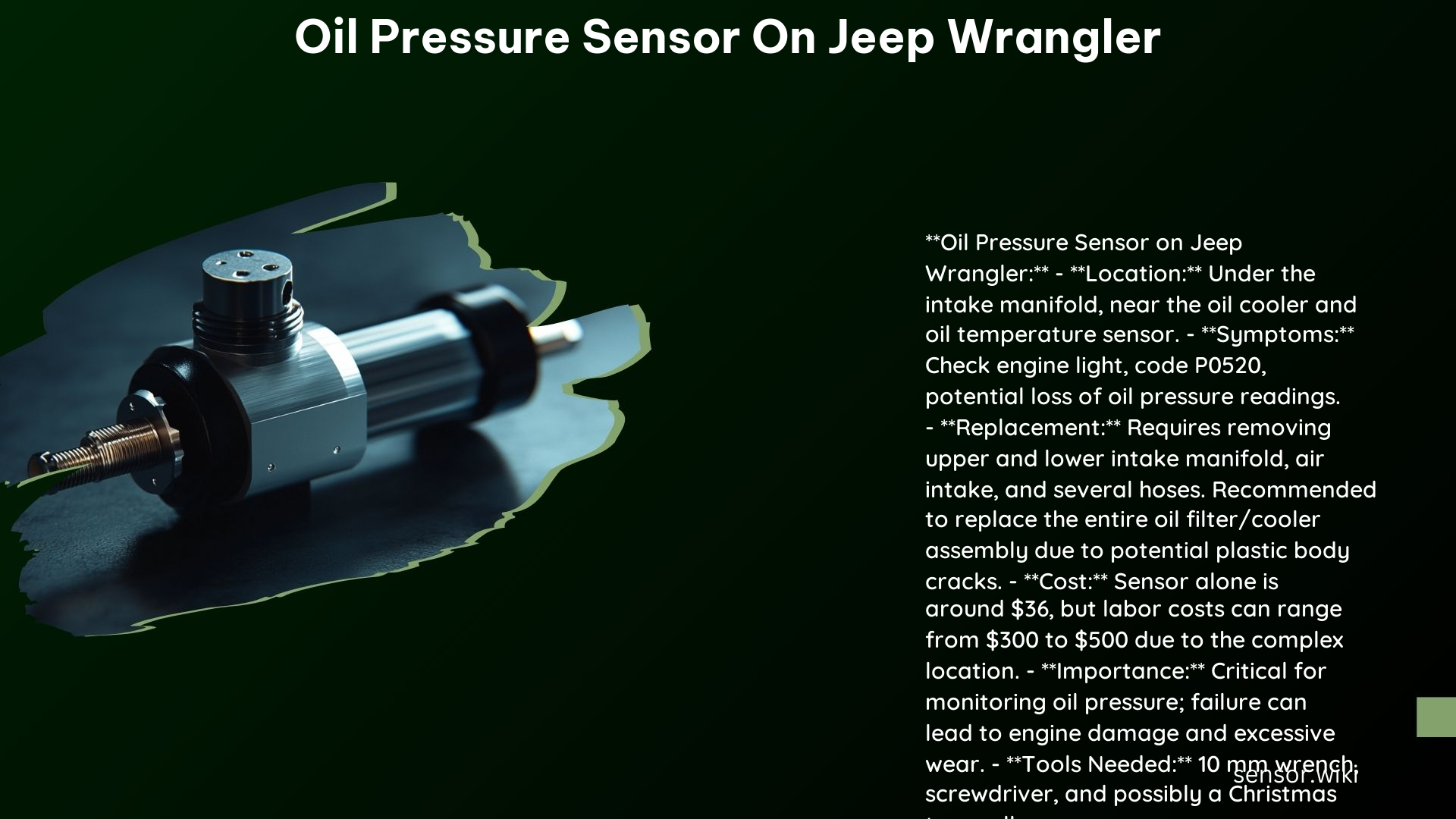The oil pressure sensor is a critical component in the Jeep Wrangler, responsible for monitoring the engine’s oil pressure and relaying that information to the vehicle’s computer and dashboard. Understanding the function, diagnosis, and replacement of this sensor is essential for maintaining the health and performance of your Jeep Wrangler.
What are the Detailed Specifications and Technical Data of the Oil Pressure Sensor on Jeep Wrangler?
Part Numbers and Compatibility
- Mopar Part Number: 05149064AA (for 2012-2018 Jeep Wrangler JK with 3.6L Pentastar V-6 engine)
- Compatibility: The oil pressure sensor is compatible with 2012-2018 Jeep Wrangler JK models, as well as other Jeep models such as the Grand Cherokee and Commander.
Design and Function
- Location: The oil pressure sensor is located under the intake manifold, specifically screwed into the oil filter adapter.
- Function: The oil pressure sensor reports the engine operating oil pressure to the dashboard light or gauge and to the engine’s computer system. It may also control the fuel pump electrical system to prevent engine damage due to low oil pressure.
What are the Common Diagnostic Procedures and Symptoms for the Oil Pressure Sensor on Jeep Wrangler?

Common Symptoms
- Oil Pressure Light Illumination: The oil pressure light on the dashboard may illuminate, indicating low oil pressure or a faulty sensor.
- Error Codes: Common error codes include P0520, which indicates a malfunctioning oil pressure sensor.
- No Start Condition: The engine may not start if the oil pressure sensor fails, as it can prevent the fuel pump from operating.
Step-by-Step Diagnostic Procedures
- Check Oil Levels: Ensure the oil level is adequate and within the recommended range.
- Scan for Error Codes: Use an OBD-II scanner to check for error codes related to the oil pressure sensor.
- Inspect the Sensor: Visually inspect the oil pressure sensor for any signs of damage or leaks.
- Replace the Sensor: If the sensor is faulty, replace it following the steps outlined below.
What are the Costs Associated with Replacing the Oil Pressure Sensor on Jeep Wrangler?
Parts Pricing
- Oil Pressure Sensor: The cost of the oil pressure sensor can range from $15 to $50, depending on the brand and quality.
Labor Costs
- Professional Labor: If done by a professional mechanic, labor costs can range from $100 to $300, depending on the complexity of the job and the mechanic’s rates.
Additional Expenses
- Tools and Materials: Additional costs may include tools and materials needed for the replacement, such as a socket set and gaskets.
- Intake Manifold Removal: Since the sensor is located under the intake manifold, removing and reinstalling the manifold can add to the overall cost and complexity of the job.
What are the Typical Oil Pressure Gauge Readings for a Jeep Wrangler?
Typical Readings
- Normal Range: The typical oil pressure reading for a Jeep Wrangler with a 3.6L engine should be around 30-60 PSI when the engine is running.
Abnormal Readings
- Low Pressure: Readings below 20 PSI can indicate low oil levels, a faulty oil pump, or a clogged oil filter.
- High Pressure: Readings above 80 PSI can indicate a malfunctioning oil pressure sensor or a blockage in the oil system.
How to Fix Oil Pressure Sensor Issues on Jeep Wrangler?
Recommended Tools and Materials
- Socket Set: A 10 mm socket is typically needed to remove the intake manifold bolts.
- Torque Wrench: To tighten the oil pressure sensor to the specified 20 Nm (177 in. Lbs.).
- Gaskets and Seals: New gaskets and seals may be required when reinstalling the intake manifold.
Step-by-Step Repair Process
- Disconnect Battery: Disconnect the negative battery cable to prevent any accidental starts.
- Remove Air Inlet Hose and Intake Manifold:
- Remove the air inlet hose and upper intake manifold.
- Disconnect the fuel injectors and fuel rail from the lower intake manifold.
- Access the Oil Pressure Sensor:
- Locate the oil pressure sensor under the intake manifold, screwed into the oil filter adapter.
- Disconnect the electrical connector from the sensor.
- Remove and Replace the Sensor:
- Remove the old sensor and replace it with the new one.
- Tighten the new sensor to 20 Nm (177 in. Lbs.).
- Reassemble:
- Reinstall the intake manifold, ensuring all bolts are securely tightened.
- Reconnect the electrical connector and any other components that were disconnected.
